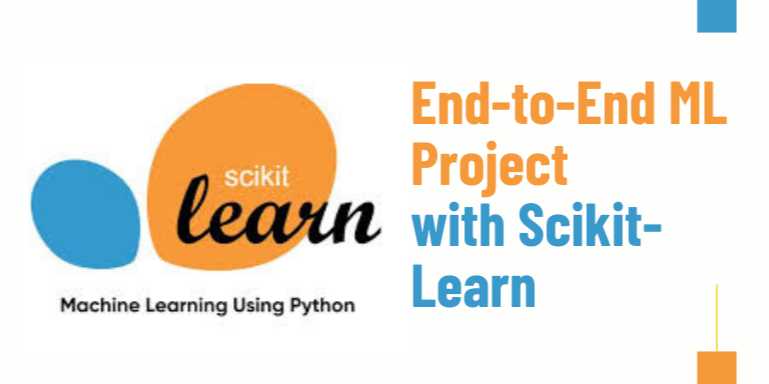A Complete End-to-End Machine Learning Project with Scikit-Learn

📖 Chapter 5: Saving, Deploying & Monitoring the Model
🧠 Introduction
Once you've trained, validated, and tuned a machine learning
model, it's tempting to think the job is done. But in the real world, a model
is only valuable when it's operationalized — that is, made available to
end users or systems for inference, then continuously monitored
to ensure it performs as expected.
This chapter covers the crucial final steps of an end-to-end
ML workflow:
- Saving
the model
- Deploying
it into a production environment
- Monitoring
and maintaining model performance over time
We'll walk through practical strategies using Scikit-Learn,
joblib, Flask, FastAPI, and monitoring frameworks. Whether you’re deploying
models in a web application, mobile app, or embedded system, this chapter will
help you build robust, production-ready ML systems.
💾 1. Saving the Model
🔧 Why Save Your Model?
After training, your model and preprocessing pipeline must
be saved so it can be reused for:
- Inference
in web/mobile apps
- Batch
processing or scheduling
- Deployment
in cloud or edge devices
✅ Tools for Model Serialization
|
Tool |
Format |
Best Use Case |
|
joblib |
.pkl |
Preferred for
Scikit-Learn models |
|
pickle |
.pkl |
General
Python object serialization |
|
ONNX |
.onnx |
Interoperability with
other platforms |
|
PMML |
.xml |
For
enterprise legacy systems |
🔍 Example: Saving and
Loading with Joblib
python
import
joblib
#
Save model
joblib.dump(trained_pipeline,
'model_pipeline.pkl')
#
Load model
model
= joblib.load('model_pipeline.pkl')
🌐 2. Deploying the Model
Model deployment makes your trained ML model accessible
to users, apps, or APIs. The two most common strategies are:
- Online
deployment: Real-time prediction via REST API
- Offline
deployment: Batch processing of files or scheduled jobs
📦 Deployment Stack
Options
|
Platform |
Tool/Framework |
Description |
|
Web API |
Flask, FastAPI |
Lightweight REST API
in Python |
|
Dashboard |
Streamlit,
Gradio |
Web UI for
model interaction |
|
Cloud |
AWS, GCP, Azure |
Scalable, serverless
deployment |
|
Docker |
Docker,
Kubernetes |
Container-based
reproducibility |
|
Mobile |
TensorFlow Lite,
CoreML |
For embedded inference |
🔧 Example: Deploying with
Flask
python
from
flask import Flask, request, jsonify
import
joblib
import
numpy as np
app
= Flask(__name__)
model
= joblib.load('model_pipeline.pkl')
@app.route('/predict',
methods=['POST'])
def
predict():
data = request.get_json()
features =
np.array(data['features']).reshape(1, -1)
prediction = model.predict(features)
return jsonify({'prediction':
prediction.tolist()})
if
__name__ == '__main__':
app.run()
🌍 Test using CURL or
Postman:
bash
curl
-X POST http://localhost:5000/predict \
-H
"Content-Type: application/json" \
-d
'{"features": [7.4, 0.7, 0.0, 1.9, 0.076]}'
⚡ Example: Deploying with FastAPI
python
from
fastapi import FastAPI
from
pydantic import BaseModel
import
joblib
class
InputData(BaseModel):
features: list
app
= FastAPI()
model
= joblib.load("model_pipeline.pkl")
@app.post("/predict")
def
predict(data: InputData):
prediction = model.predict([data.features])
return {"prediction":
prediction.tolist()}
Run using:
bash
uvicorn
filename:app --reload
✅ Best Practices for Deployment
- Version
control your models
- Use pipelines
to include preprocessing
- Handle
invalid or missing inputs
- Log
all predictions and errors
- Implement
authentication and throttling for APIs
🔄 3. Batch Inference vs
Real-Time Inference
|
Mode |
Description |
When to Use |
|
Batch |
Predict in bulk,
stored in files |
Reporting, offline
analytics |
|
Real-time |
Predict
instantly via API |
Chatbots,
recommendation engine |
Example for batch processing:
python
import
pandas as pd
data
= pd.read_csv('input.csv')
predictions
= model.predict(data)
pd.DataFrame(predictions).to_csv('output.csv')
📊 4. Monitoring Model
Performance
Once a model is in production, it may drift over time
due to:
- Changing
user behavior
- Seasonal
shifts
- Data
schema updates
- External
events (e.g., pandemics)
Monitoring ensures your model still performs well.
⚙️ What to Monitor:
- Input
data drift
- Model
prediction drift
- Prediction
latency
- Error
rate or accuracy
- User
feedback loop
🔍 Tools for Monitoring
|
Tool |
Use Case |
|
Evidently AI |
Monitor data &
prediction drift |
|
MLflow |
Track
metrics, experiments |
|
Prometheus +
Grafana |
Monitor infra &
model stats |
|
BentoML |
Model serving
with monitoring |
|
Custom logging |
Track requests and
errors |
🧪 Example: Logging
Predictions
python
import
logging
logging.basicConfig(filename='model_log.log',
level=logging.INFO)
@app.route('/predict',
methods=['POST'])
def
predict():
...
logging.info(f"Input:
{data['features']} | Prediction: {prediction.tolist()}")
...
🔐 5. Securing Your Model
API
Security is often overlooked during ML deployment.
- Input
validation: Validate types and dimensions
- Authentication:
API keys, OAuth
- Rate
limiting: Throttle excessive requests
- HTTPS:
Encrypt communication
- Audit
logging: Track suspicious access
🔁 6. Model Updating and
Retraining
Model performance may degrade. Common updating methods:
- Manual
retraining every week/month
- Scheduled
retraining using cron jobs or pipelines
- Active
learning based on user feedback
- Online
learning (for algorithms that support it)
📦 CI/CD for ML (MLOps)
|
Phase |
Tool |
Function |
|
Versioning |
DVC, Git, MLflow |
Track datasets and
models |
|
Testing |
Pytest,
Unittest |
Validate
model functionality |
|
Deployment |
Docker, Jenkins,
GitHub Actions |
Automate deployment |
|
Monitoring |
Prometheus,
Grafana |
Observe
metrics |
🧾 Summary Table: Model
Deployment Workflow
|
Stage |
Tool or Method |
|
Save Model |
joblib, pickle |
|
Build API |
Flask,
FastAPI |
|
Batch Inference |
pandas,
model.predict() |
|
Real-Time Inference |
RESTful endpoints |
|
Monitoring |
Evidently AI,
Prometheus |
|
Retraining Strategy |
Cron jobs,
active learning |
|
Security &
Logging |
Logging, HTTPS, token
auth |
💡 Conclusion
Building a high-performing model is only half the battle — the real-world impact of machine learning comes from operationalization. Deploying your models in a scalable, secure, and monitored way allows your organization to extract value continuously.
From saving pipelines to launching APIs, from logging usage
to retraining strategies, this chapter completes your understanding of an
end-to-end machine learning project. With these skills, you're equipped to transition
from ML developer to ML engineer — someone who ships production-grade,
value-driven AI solutions.
FAQs
1. What is meant by an end-to-end machine learning project?
An end-to-end machine learning project includes all stages of development, from defining the problem and gathering data to training, evaluating, and deploying the model in a real-world environment.
2. Why should I use Scikit-Learn for an end-to-end ML project?
Scikit-Learn is widely adopted due to its simplicity, clean API, and comprehensive set of tools for data preprocessing, modeling, evaluation, and tuning, making it ideal for full ML workflows.
3. Can I use Scikit-Learn for deep learning projects?
Scikit-Learn is not designed for deep learning. For such use cases, you should use frameworks like TensorFlow or PyTorch. However, Scikit-Learn is perfect for classical ML tasks like classification, regression, and clustering.
4. How do I handle missing values using Scikit-Learn?
You can use SimpleImputer from sklearn.impute to fill in missing values with mean, median, or most frequent values as part of a pipeline.
5. What is the advantage of using a pipeline in Scikit-Learn?
Pipelines help you bundle preprocessing and modeling steps together, ensuring consistency during training and testing and reducing the chance of data leakage.
6. How can I evaluate my model’s performance properly?
You should split your data into training and test sets or use cross-validation to assess performance. Scikit-Learn offers metrics like accuracy, F1-score, RMSE, and R² depending on the task.
7. Is it possible to deploy Scikit-Learn models into production?
Yes, models trained with Scikit-Learn can be serialized using joblib or pickle and deployed using tools like Flask, FastAPI, or cloud services such as AWS and Google Cloud.
8. What is cross-validation and why is it useful?
Cross-validation is a method of splitting the data into multiple folds to ensure the model generalizes well. It helps detect overfitting and gives a more reliable performance estimate.
9. How do I tune hyperparameters with Scikit-Learn?
You can use GridSearchCV or RandomizedSearchCV to automate hyperparameter tuning and select the best model configuration based on performance metrics.
10. Can Scikit-Learn handle categorical variables?
Yes, using transformers like OneHotEncoder or OrdinalEncoder, and integrating them within a ColumnTransformer, Scikit-Learn can preprocess both categorical and numerical features efficiently.
Tutorials are for educational purposes only, with no guarantees of comprehensiveness or error-free content; TuteeHUB disclaims liability for outcomes from reliance on the materials, recommending verification with official sources for critical applications.
Explore Other Libraries
Please allow ads on our site
Kindly log in to use this feature. We’ll take you to the login page automatically.
Login
Join Our Community Today
Ready to take your education and career to the next level? Register today and join our growing community of learners and professionals.

Your experience on this site will be improved by allowing cookies. Read Cookie Policy
Your experience on this site will be improved by allowing cookies. Read Cookie Policy
Comments(2)